Click image for BBB rating
See our Privacy Policy
Welcome to Spaightwood Galleries, Inc.
120 Main Street, Upton MA 01568-6193
You can follow us on Facebook and Twitter!
We blog regularly on Facebook and announce special events and special sales on both sites.
Last updated: 3/23/2017
Claude Garache (French, b. 1929): Paintings
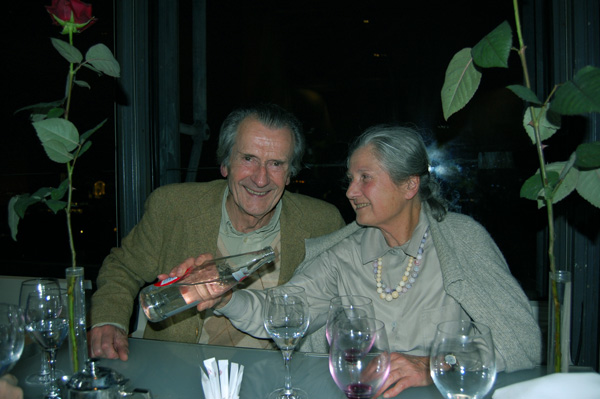
Pictured at left: Claude Garache, Nov. 2007; below: Claude and Helene Garache at the Pompidou Restaurant, Nov. 2007.
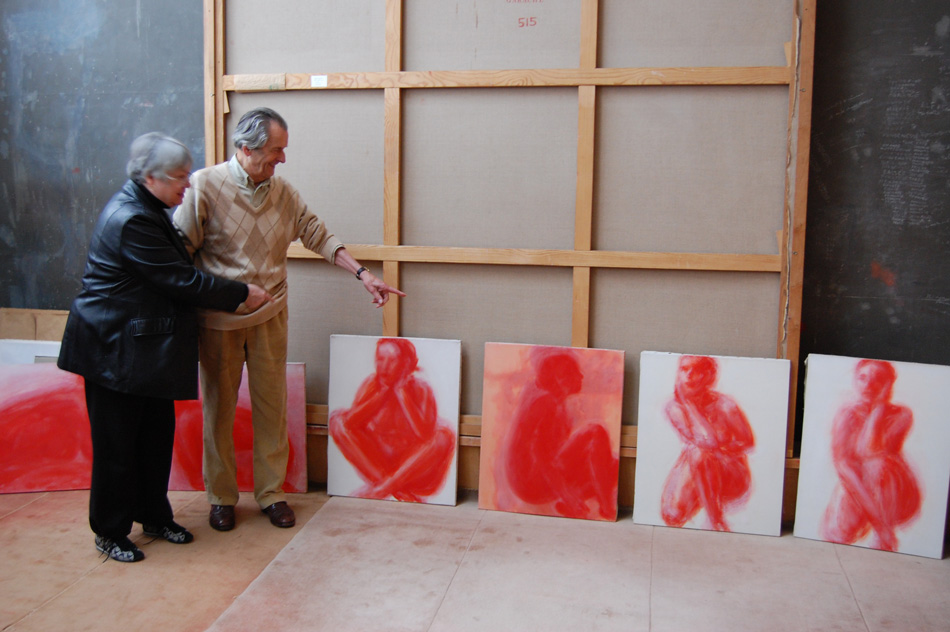
Claude Garache and Sonja Hansard-Weiner at Garache's Paris studio, Nov. 2007, examining 6 of his recent small paintings as some of them lean up against the reverse of one of his larger paintings.
Keep working your way down: 8 Garache paintings await you.
An artist’s artist, Garache was first recommended to Aimé Maeght, the most important art-dealer in post-war France, by two of Maeght’s most important artists, Joan Miró and Marc Chagall. Although Garache’s subject is exclusively the female body, the Surrealist Raoul Ubac and the Post-War School of Paris abstract-artist Pierre Courtin have written prefaces to Garache’s exhibition catalogues. An art historian’s artist, Garache has been the subject of analyses by Marc Fumaroli (Italian Renaissance art), Jacques Thuillier (books on Georges de la Tour and Nicolas Poussin), and Dora Vallier (Georges Braques). A poet’s artist, Garache has frequently collaborated with and/or been the subject of essays or poetry by the poets Yves Bonnefoy, Jean Frémon, Grand Prix national de la poésie winner Edmund Jabès, Philippe Jacottet, Nobel Prize-winner Claude Simon, and Alain Veinstein. Garache appeals as well to intellectual historians like Georges Duby (medieval culture) and Jean Starobinski (Montaigne, France in the Eighteenth Century and the French Revolution) and to literary critics like Richard Stamelman (contemporary poetry, Yves Bonnefoy), Judith Miller (contemporary avant-garde and feminist French theater), and Peter Schofer (Nineteenth-Century French Poetry).
Living and working in Paris, Claude Garache (b. 1929) has achieved that balance of surprise and inevitability (the blending of an individual talent and a viable tradition) that marks the works of Degas and Matisse, Derain and Giacometti. Looking at Garache’s oeuvre, we recognize works that immediately proclaim themselves as "classic," yet which are more disturbing than we expect classic art to be. Rather than confronting the source of this disturbance, it is tempting to concentrate instead on Garache’s technical virtuosity. As a painter, Garache is a perfectionist, layering on wash after wash of color, building up depth and intensity, establishing both a ground and an almost 3-dimensional shape looming out of that ground. Garache is an established master of the aquatint, whose graphics are regularly included in the Bibliothèque Nationale’s five-year surveys of the most important work in prints and were similarly included in shows at the Museum of Modern Art in New York, the Fifth European Print Bienniale, and have been featured in one-person shows at museums and galleries in the U.S., Belgium, England, France, Germany, and Spain. He is also a superb lithographer, whose sense of color and texture produces fascinating and compelling studies of the human figure, his only subject.
But admiration of technique alone is not an ultimately satisfying stopping point, particularly for works such as these, whose content demands a response that acknowledges both their emotional power and the intellectual challenge they provoke. Despite its reliance upon the female body, Garache’s work, however erotic it may be, is not exploitive. It invites us to share not only in the beauty of the body but in its vulnerability as well, not simply in its here-and-now physicality but also in its fetal past and its uncertain future. Garache offers us a view of the mirror in which we see ourselves, and the image he shows us is one that clearly demands comparison with one of his most imposing predecessors, Alberto Giacometti, whose sculptures, drawings, printings, and paintings captured—at least for such writers as Jean Paul Sartre and Jean Genet—the existential absurdity of the post-war world. Giacometti’s people reveal the self-image of the late forties and fifties. Hard and untouchable, these figures wander alienated and forever frozen behind masks of their own making which deny the possibility of anything but the loneliness from which, unavailingly, they would so much like to escape.
Garache, however, seems to see a present which does not deny the ultimate inescapable vulnerability of his subjects yet which is not without hope. The female body, whether depicted in paint, charcoal, crayon, aquatint, or lithograph, has become in his works the symbol through which we can understand Garache’s view of the human condition. Relentlessly yet lovingly, he explores the beauty and the pain of human experience through the image of the nude. His works, as Georges Barrière observed in Chroniques de l’Art Vivant (May-June, 1975), "achieve the resonance of a beautiful poem or psalm through repeated incantations of the one theme . . . which, through an infinite series of comparisons, symbolizes rebirth." Whether withdrawn into themselves for protection or contemplation, lying tensely or languorously, leaping up from depths we cannot imagine or falling into a void whose bottom is not evident, fleeing from sights we would not necessarily desire to see or running joyfully towards a destination we cannot yet see, his subjects exist in a world which we are compelled to acknowledge as our own. His art shows us people with a fear of the past and doubts about the future who nonetheless join to that a willingness to exist in the present and often to joy in that existence. Claude Garache offers us x-rays of the psyche, ultra-sound scans of a womb-like world in which the acknowledgment of universal vulnerability may be a necessity for survival as well as a threat to it. These works invite us to imagine a world in which we do not have to make ourselves stone-hard to endure, perhaps even a world where our sense of the limits of the human can keep us exultantly and ecstatically whole.
Garache’s image remains the female nude. As Garache, whom Dora Vallier has called the first post-abstract master of the nude, said in an interview with critic Jacob Stockinger, "My women are genderless. They are human beings, they represent all people." His works continue to assert the strength of openness, a strength arising out of a recognition of the mutuality—even the universality—of vulnerability and out of the freedom that accompanies that recognition. Stockinger suggests that "Once viewers have seen his work, they are unlikely to forget the style. To the degree that he has fashioned at least his own visual language, and that viewers are not likely to confuse his work with anybody else’s, he admits success." No one who has seen his work is likely to mistake these for the work of any other artist, and once they have seen these powerful and joyful new works they are unlikely to forget them.
With the publication in 1988 of Jean Starobinski’s important book, Garache (published by Flammarion) with texts in both French and English, Garache’s work has become more accessible to English-speaking audiences, and there have been a number of shows in New York, San Francisco, and Seattle galleries. We are pleased at M. Garache’s recent success, having given him his first one-person exhibition in the U.S. (in 1982, followed by solo exhibits in 1983, 1984, 1985, 1988, 1990, 1991, 1993, 1994, 1997, and 1999), and continue to show his work and to maintain the largest inventory of it in the United States. Claude Garache has published nearly 200 aquatints, etchings, and lithographs, and Sightwood Galleries has examples of almost all of them, along with several paintings and a number of drawings. Spaightwood Galleries remains firmly committed to the art of Claude Garache, not just for its beauty, but for the stories it invites us to tell each other. As Richard Stamelman, whose perceptive essay on Garache is featured in the catalog of the Wesleyan University retrospective of Garache’s prints, observes, Garache’s "art suggests that he sees the body as a way of being in the world, of existing in concert with the rhythms of living and dying that modulate human activity, and of engaging with and reaching out to the corporeal reality of other human beings. For Garache, the body (or, more pointedly, what he describes as ‘the precariousness, the fragility, of this marvel, this magnificent being, that is the human body’) is a place of passage and of momentary coalescence where ‘the Real’ becomes visible."
The paintings depicted below, Victoire (G. 125), Victoire (G. 144), Bouge (G. 428), Bouge (G. 434), Epiare, Appe, Dos, Narette, and Stanton Claire, once again present Garache celebrating the mystery of the human body. In these figures, in their movement, their gestures, their powerful sense of agency, we sense again, as Jacques Thuillier did thirty-six years ago (in "Notes brèves sur Claude Garache," Derrière Le Miroir, 1975), that "The unity of Garache’s work evokes the unity between being and non-being, between hope and despair. . . . The audacity of Garache is in his affirmation that health, sweetness, and happiness may all be contained in a woman’s body."
Please contact us for additional information.
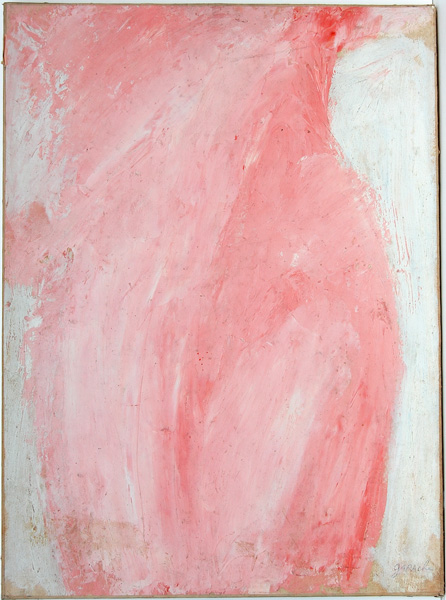
Victoire (G. 125). Oil on paper mounted on canvas, 1959. One of Garache's most important early paintings, signed in pencil lower right and with his inventory number on the reverse. Illustrated in Jean Starobinski's Garache (Paris: Flammarion, 1988), an important monograph with an introduction in both French and English. Provenance: Claude Garache to Etienne Hajdu (1959), a well-respected French modernist sculptor and a good friend of Claude and Helene Garache, to Spaightwood Galleries (2007). Image size: 757x566mm (29-3/4"x22-1/4"). Price: Please call or email for current pricing information.
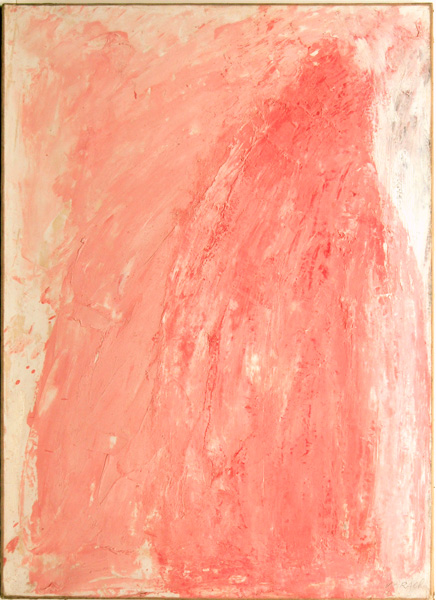
Victoire (G. 144). Oil on paper mounted on canvas, 1959. Signed in pencil lower right and with his inventory number on the reverse. Unlike Garache's later paintings, which have smooth surfaces and are made up of many layers of oil washes, this painting reveals Garache's early history both as a sculptor and as a painter interested in 3-dimensional surfaces. Provenance: Claude Garache to Etienne Hajdu (1959), a well-respected French modernist sculptor and a good friend of Claude and Helene Garache, to Spaightwood Galleries (2007). Image size: 757x566mm (29-3/4"x22-1/4"). Price: Please call or email for current pricing information.
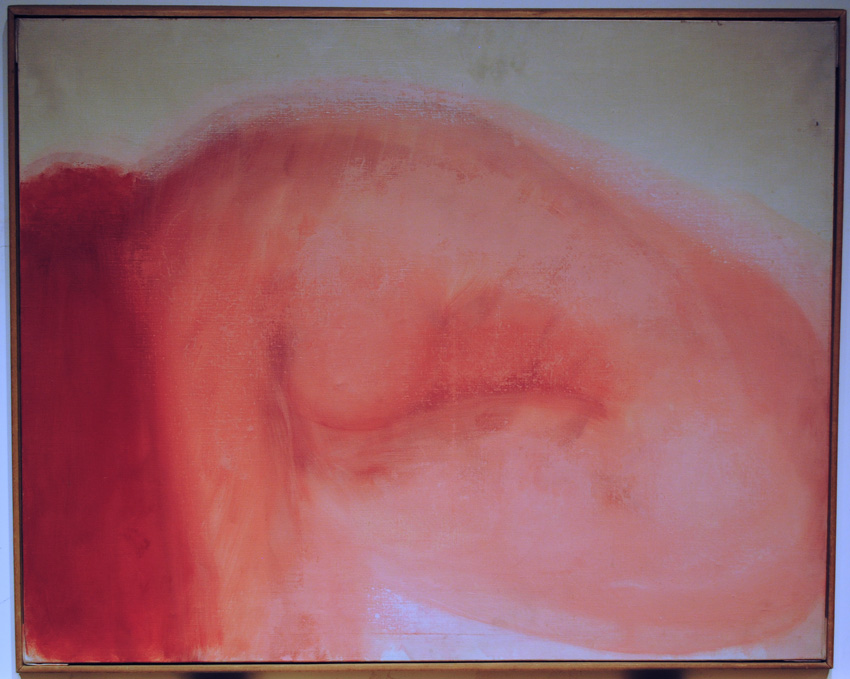
Bouge (G. 428). Oil on canvas, 1973. Signed on the reverse as always and with Garache's inventory number (428). Garache names his paintings by the model's pose. This is one which Garche employed (with many variations) in paintings and etchings during 1973-74. Image size: 730x915mm (29-3/4x36 inches). Price: Please call or email for current pricing information.
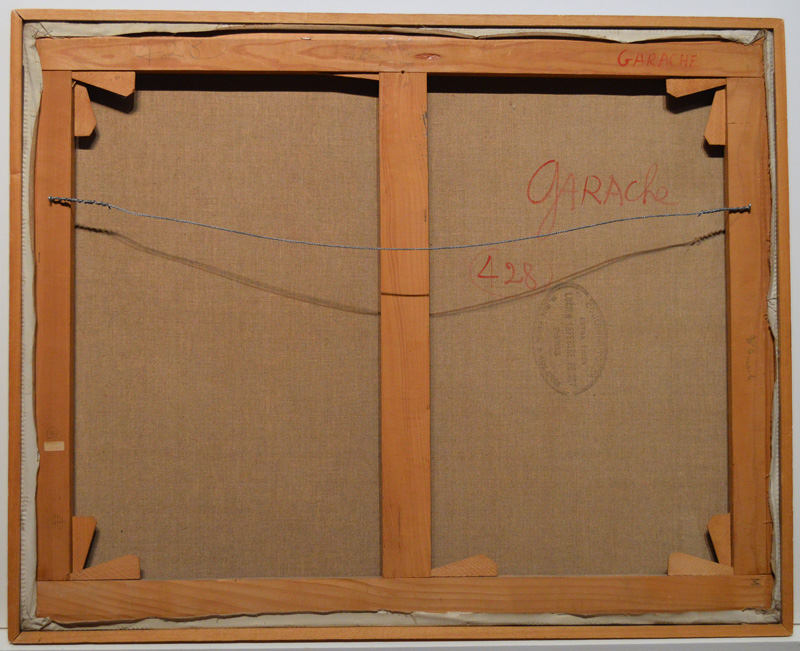
Bouge (G. 428). Oil on canvas, 1973. Signed on the reverse as always and with Garache's inventory number (428).
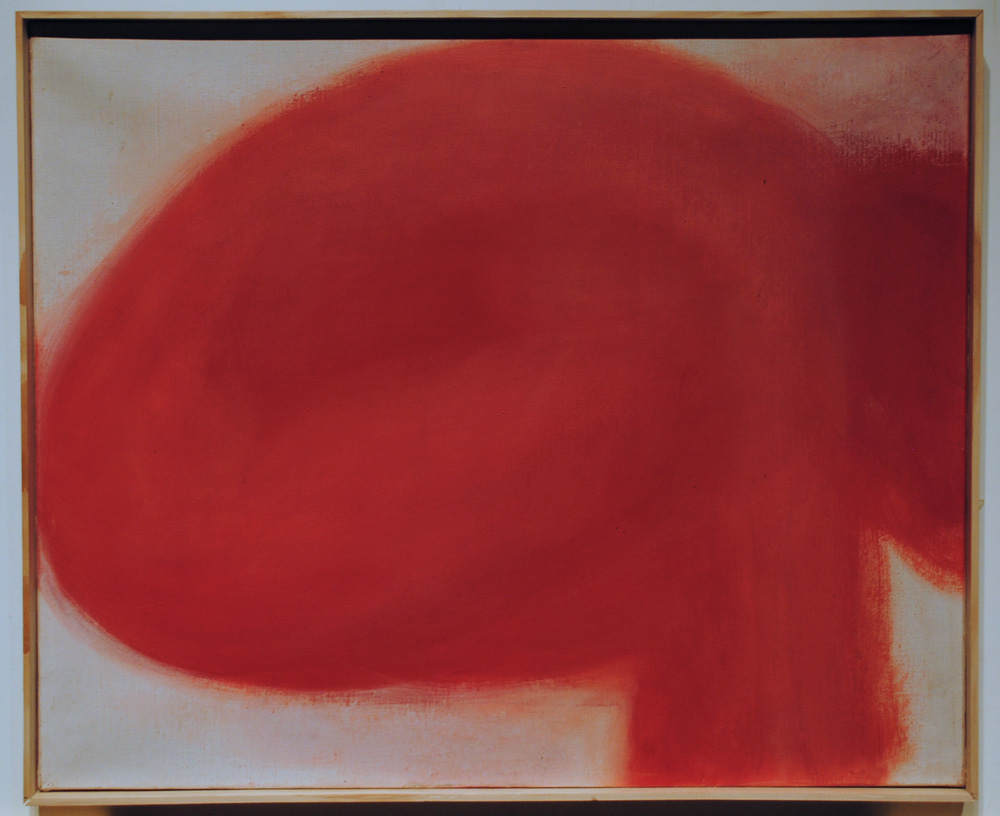
Bouge (G. 434). Oil on canvas, 1973. Signed on the reverse as always and with Garache's inventory number (434). Garache names his paintings by the model's pose. This is one which Garche employed (with many variations) in paintings and etchings during 1973-74. Image size: 597x725mm (23-1/2x28-1/2 inches). Price: Please call or email for current pricing information.
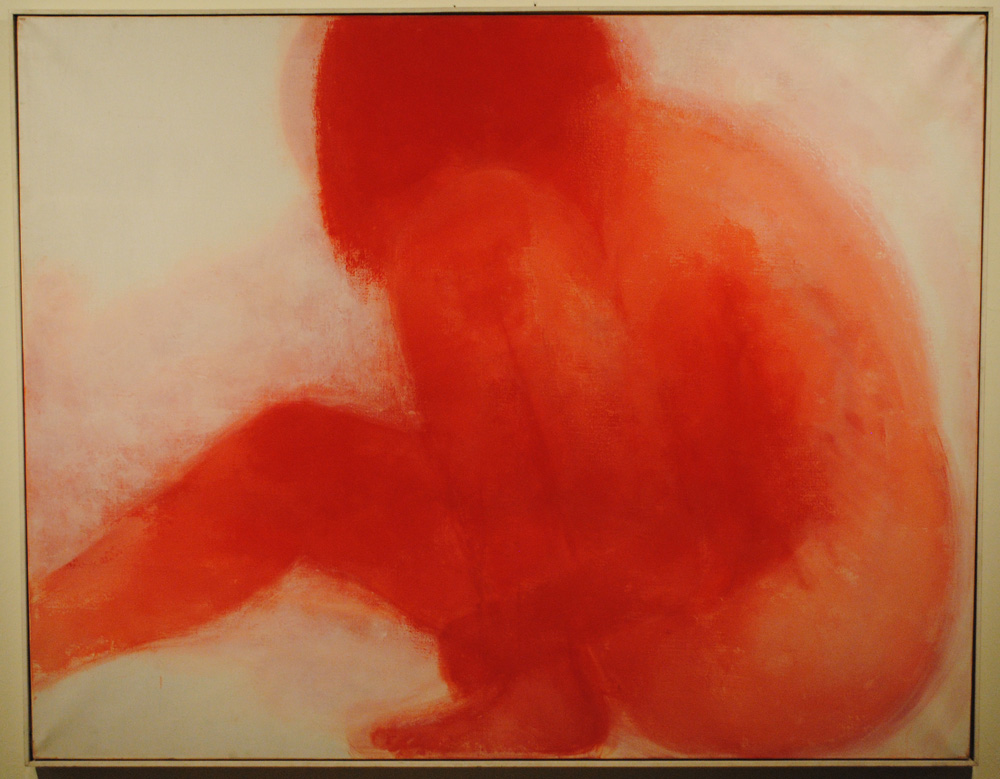
Epiaire. Oil on canvas, 1980. Signed in red on the reverse and stamped GARACHE in red; in red; with the label of Gallerie Maeght and their address on one of the stretcher bars on the reverse. A classic example of one of Garache's great studies of the female body and psyche. Illustrated in a special issue of the deluxe art review Derriere le Miroir dedicated to Garache (see plate 12). Image size: 1160x1460mm (45-7/8x57-1/2 inches). Price: Please call or email for current pricing information.
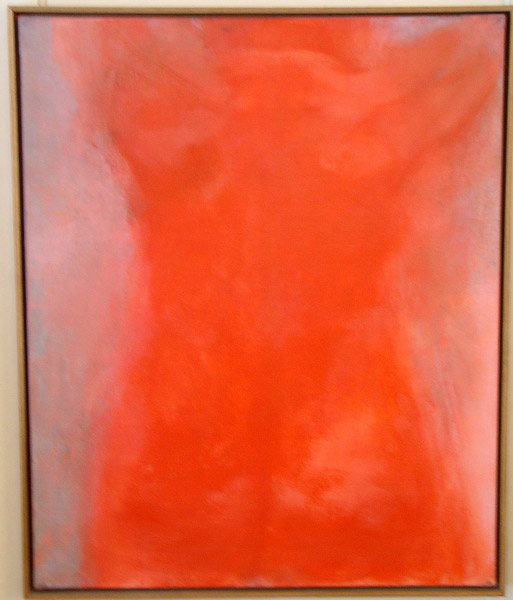
Dos (G. 623). Oil on canvas, 1980. Signed on the reverse as always. Illustrated in a special issue (n. 12) of the art review "reperes" dedicated to Garache (1984). Image size: 730x600mm (28-3/4x23-5/8 inches). Price: SOLD

Stanton Claire. Oil on canvas, 1980. Signed on the reverse as always. Illustrated in a special issue (12) of the art review reperes dedicatd to Garache (1984). Image size: 1460x1160mm (57-1/2x45-7/8 inches). Price: SOLD.
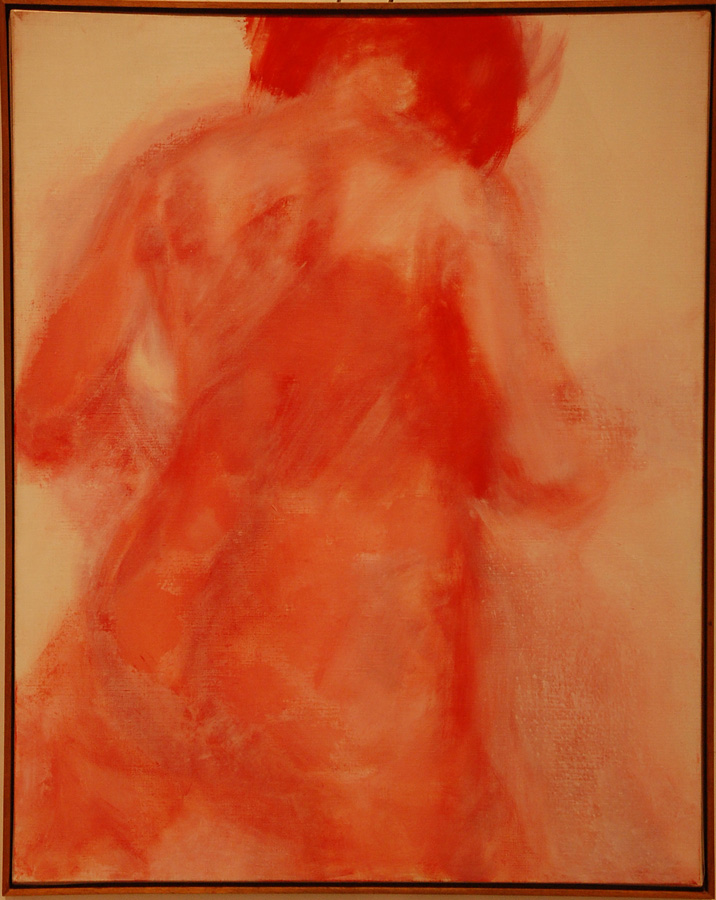
Appe (G. 607). Oil on canvas, 1983. Signed on the reverse as always. Image size: 920x730mm (36-1/4x28-3/8 inches). Price: SOLD.
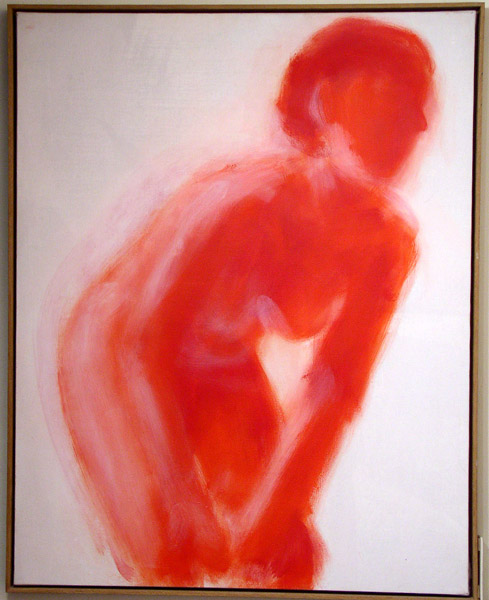
Narette (G. 732). Oil on canvas, 1995. Signed on the reverse as always. Image size: 920x730mm (36-1/4x28-3/8 inches). Price: Please call or email for current pricing information.
Select Bibliography
Yves Bonnefoy, "In Garache’s Color" ("Dans la couleur de Garache") was originally written for an exhibition held 9 February–10 March 1974, at the Fondation Maeght and published in Garache (Saint-Paul-de-Vence: Fondation Maeght, 1974). It was subsequently reprinted in Le nuage rouge: Essais sur la poétique (Paris: Mercure de France, 1977); and in Le nuage rouge: Essais sur la poétique, rev. ed. (Paris: Mercure de France, 1992). Richard Stamelman’s English translation appears in the University of Chicago Press’ volume of Yves Bonnefoy’s art criticism, The Lure and the Truth of Painting: Selected Essays on Art (Chicago: the University of Chicago Press, 1995). Bonnefoy also wrote "Peinture, Poésie, Vertige, Paix," Derrière le Miroir, n. 213 (Paris: Galerie Maeght, 1975), reprinted in Le nuage rouge; "On Painting and Poetry, Anxiety and Peace," an English translation by Mortimer Guiney is available in The Lure and the Truth of Painting: Selected Essays on Art.
Pierre Courtin, "Chronique amicale," Garache: Peintures, an exhibition catalogue published by the Musée Saint-Roch, Issoudun, 1991.
Marie du Bouchet, Florian Rodari, Alain Madeleine-Perdrillat, Entretiens avec Claude Garache (Paris: Editions Hazan, 2010).
Georges Duby, "Préface," Garache, an exhibition catalogue published by the Musée d’Orange, Orange, 1992.
Jacques Dupin, Garache, Dessins (Paris: Societie nouvelle Adam Biro, 1999).
Michael Edwards, "Claude Garache: Painting and Repetition," an exhibition catalogue published by the Galerie Matisse, Institut Français, London, 1994.
Jean Frémon, "Une version du réel," Garache, an exhibition catalogue published by the Musée Grobet-Labadie, Marseilles, 1983.
Marc Fumaroli, "Depuis longtemps, Vénus . . ." Repères: Cahiers d’art contemporain 50 (Paris: Galerie Lelong, 1988).
Edmond Jabès, Désir d'un commencement, Angoisse d'une seule fin (Paris: Fata Morgana, 1991; the deluxe version [65 unbound folios] of this collaboration contains 3 large etchings with aquatint; the regular edition contains reproductions of three of Garache's drawings)
Edmond Jabès, "Lettre à Claude Garache," Un regard (Montpellier: Fata Morgana, 1992).
John E. Jackson, "Notes pour Garache" accompanying and introducing Claude Garache, "Seize Dessins/ 16 drawings," L'harmonie (Orleans-Meaux: Institut d'Arts Visuels, 2000), 109-130.
Philippe Jacottet, "(A la fin de janvier)." Repères: Cahiers d’art contemporain 12 (Paris: Galerie Maeght Lelong, 1984).
Gilles Lipovetsky, La troisème femme: Permanence et révolution du feminin (Paris: Gallimard, 1997), reproduces one of Garache's drawings on the front cover of the book.
James McAllister, "The Image and the Furrow: Yves Bonnefoy and Claude Garache," Symposium 45 (1991), 97-108.
Judith G. Miller, "Bloodstone: Claude Garache and His Models," Graven Images 2 (1995), 7-10.
Florian Rodari and Yolaine Destremau, ed., Garache face au modèle (Geneva: La Dogana, 2006). A collection of important essays about Garache by Raoul Ubac, Florian Rodari, Yves Bonnefoy, Philippe Jaccottet, Roger Munier, Emmanuel Lauggier, Alain Madeleine-Perdrillat, Jacques Dupin, Anne de Staël, Nicolas Pesquès, François Trémolières, Michael Edwards, Jean Starobinski, John E. Jackson, and Pierre-Alain Táche accompanied by 37 color reproductions of paintings, drawings, and prints.
Peter Schofer, "Painting Rewrites Poetry: Baudelaire Through the Eyes of Claude Garache," Graven Images 2 (1995), 21-27.
Richard Stamelman, "The Incarnation of Red," was originally published in the catalogue for the exhibition Claude Garache: Prints 1965-1985, 17 October-24 November 1985, Ezra and Cecile Zilkha Gallery, Wesleyan University. It has been reprinted in French in Claude Garache, an exhibition catalogue published by the Centre d’Art Contemporain, Istres, 1993. Stamelman has also written on the relationship between Garache and Bonnefoy: "Transfigurings of Red: Color, Representation and Being in Yves Bonnefoy and Claude Garache," The Comparatist 10 (May 1986), 89-107, and "The Presence of Light/The Light of Presence: Yves Bonnefoy," Dalhousie French Studies 21 (Fall-Winter 1991), 43-59.
Jean Starobinsksi, Garache (Paris: Flammarion, 1988), an important monograph with the text in both French and English. Starobinski has also written "Officiantes," Garache, an exhibition catalogue published by Galerie Maeght, Zurich, 1976, and revised and extended for republication in Repères 12 (1984). Also by Starobinski: "Si cette figure porte un nomme," Pour un temps/Jean Starobinski, ed. Jacques Bonnet (Paris: Centre Georges Pompidou, 1985), 274-5, and "La caresse et le fouet, Andre Chenier": Oeuvres do Claude Garache (Geneva, 2000)
Italo Svevo, Une Vie, trans. from Italian to French by Georges Piroué (Paris: L'Etrangère Gallimard, 1991) reproduces a detail of one of Garache's paintings, Epiairoue, on the front cover.
Jacques Thuillier, "Notes brèves sur Claude Garache," Derrière le Miroir, n. 213 (1984), 15-24.
Raoul Ubac, "Garache," Garache, an exhibition catalogue published by Galerie Michel Vokaer (Brussels, 1972).
Dora Vallier, "Claude Garache," Derrière le Miroir, n. 150 (1965), 18-23.
Alain Veinstein, "Archéologie de la mère," Derrière le Miroir, n. 237 (1980), 1-16. Reprinted in his Ebauche du féminin (Paris: Maeght, 1981), 31-69
Andrew D. Weiner, Claude Garache, Exhibition catalogue published on the occasion of the release of Bleue V and Bleue VI by Spaightwood Galleries, 1995; this essay was reprinted in "Petite Daquine," Graven Images 2 : Studies in Culture, Law, and the Sacred: The Body (Madison: University of Wisconsin Law School, 1995), accompanied by 9 illustrations of his prints and paintings.
Major museum exhibitions:
Dans la couleur de Garache (Musée d'art moderne de la ville de Paris, 29 March-24 June 2012); Garache Peintures (École Supérieure des Beaux-Arts, Nimes, 30 April-24 May, 2010); Garache Peintures (Istres Centre d'Art Contemporain, 18 November 1993-8 Janary 1994), Garache: Pintures, Pastels i Dibuixos (Galeria Trama, Barcelona, 12 May-9 June, 1992); Garache: Peintures (Musée d'Orange, 5 July-5 September, 1992); Garache Peintures (introduction by Pierre Courtin: Musée St-Roch, 2June-10 September 1991); Claude Garache Prints 1965-1985 (Ezra and Cecile Zilkha Gallery, Wesleyan University, Middletown CT, 17 October-Novemer 24, 1985), Garache (Musée Grobet-Labadié, Marseille, November 1983-January 84); Garache (Fundació Maeght, Saint-Paul-de-Vence, 1974).
The last listing (1992) we could find of museums holding Garache's works includes the Musée National d'Art Moderne, Centre George Pompidou, Paris; the Museum of Modern Art, NY; the Hirshhorn Museum and Sculpture Garden, Washington D.C., Fonds National d'Art Contemporain, Paris; Findation Maeght, St.-Paul de Vence; Musée Cantini, Marsella; davison Art Center, Wesleyan University, Middletown CT; Bibnliothèque Nationale, Paris; Cincinnati Museum, Cincinnati UH.
Spaightwood Galleries, Inc.
To purchase, call us at 1-800-809-3343 (1-508-529-2511 in Upton MA & vicinity) or send an email to spaightwood@gmail.com
We accept AmericanExpress, DiscoverCard, MasterCard, and Visa.
We also accept wire transfers and paypal.
For directions and visiting information, please call. We are, of course, always available over the web and by telephone (see above for contact information). Click the following for links to past shows and artists. For a visual tour of the gallery, please click here. For information about Andy Weiner and Sonja Hansard-Weiner, please click here. For a list of special offers currently available, see Specials.
All works are sold with an unconditional guarantee of authenticity (as described in our website listing).
Copyright 2004-2017, Spaightwood Galleries, Inc.
Go back to the top of this page.
Visiting hours: Saturday 10:00 am to 5:00 pm and Sunday noon to 6:00 pm and other times by arrangement.
Please call to confirm your visit. Browsers and guests are welcome.

Claude Garache and Sonja Hansard-Weiner enjoying the sculptures by Niki de Saint-Phalle and Jean Tinguely in the fountain across the street from the Centre Pompidou in 2007.












